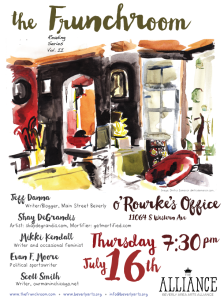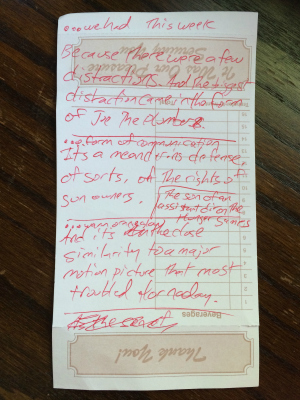
Yesterday I experienced an afternoon of celebration, reflection and conversation at St. Barnabas Church, where I’m a parishioner. The event was “Following Big Shoes – What Is Ours Yet To Do?” It focused on the past, present and future of the civil rights movement. Specifically, we discussed the work that needs to be done for civil rights in Chicago, now, to eradicate the scourge of gun violence in this city. There was passion and the comfort of shared mission.
The event was part of the Thou Shalt Not Murder campaign, led by a group of South Side churches and pastors leading up to a day without murder or shootings: March 27th, Easter Sunday. Please visit the website, read about the upcoming events and consider adding your voice to those who call for a day without murder in this city.
I will write more about this campaign later, but yesterday’s conversation (and specifically the line “what is ours left to do”) reminded me of an op-ed I wrote that originally ran in our neighborhood paper, The Beverly Review, during the last week of 2015. Our neighborhood is one of the few in Chicago that has an integrated population, but it didn’t come without a fight. The events in this country of the last year proved that the fight against racism isn’t over, nor is it enough for neighborhoods like mine to rest on its laurels. This column is specifically about the neighborhood of Beverly/Morgan Park, but likely has some relevance for you no matter where you live.
In all honesty, this column is a lot more gentle than anything I’d normally publish here. It’s absent the anger I feel about the incidents that led to it. And I purposely sidestepped calling out the neighborhood Facebook groups that are rife with stereotypes and some of the worst things I’ve read about anyone. But I wasn’t trying to reach them; I’m trying to reach those who disagree but feel cowed into silence by the hate they see. It’s those whose voices we need the most: the ones who hadn’t ever thought they can play a role in pushing back.
—
As winter takes hold and the year begins to draw to a close, I’ve been thinking about the past year and taking an inventory of my life in the past twelve months – work and home, good and bad, what I’ve done and what I’ve left undone.
When I’m thinking about the past year’s accomplishments and next year’s priorities, I often find myself thinking in terms of a checklist: which tasks are one-time events that can be forgotten once they’re done and which ones are ongoing tasks that need regular effort?
I’ve thought about this in terms of our neighborhood, too, and how most things we think of as one-and-done really ought to be ongoing matters that always get our attention.
All of which brings me around to matters of diversity and race in our area.
Our community is one of the few in the highly segregated city of Chicago that can claim a measure of racial integration. According to the 2010 census, Beverly’s population is 65% white, 32% black, 3% Hispanic. Morgan Park is 66% black, 29% white, 3% Hispanic. But this mix did not happen naturally.
The racial makeup of Beverly changed only after hard work, court fights and the bravery of those who persevered in the face of stiff opposition. A report last year by WBEZ’s Curious City program detailed this change. Beverly was 99% white in 1970. Members of the Beverly Area Planning Association pushed (and sued) realtors to avoid racially-motivated steering while also speaking to parishes and neighbors about the importance and benefits of an integrated community. A few brave black families began to move here. In the next ten years, the black population in Beverly would grow to 14%.
All of this gives our neighborhood a unique history. But what about our future? Or our present?
Our community’s current racial makeup may lead some of us to think that our efforts at integration can be checked off the list. Yet over the past couple years, it’s distressed me that our neighborhood has too often made local and even national headlines for incidents of racism. Just like in the 1970s, it is not a problem that will go away on its own without the help of people who live here. It will require bravery, honesty and a commitment from those with power.
Of course, our neighborhood is not alone in this struggle. As this country becomes more diverse, it is re-examining its own racial past and asking what work still needs to be done. While we’ve come far as a nation, we have a ways to go before we remove all the structural, economic and cultural barriers that prevent us from living up to the ideals of liberty and justice for all.
We can do this here. And we can do this now.
As with most things, stepping outside of our own experiences is the first step. Our community is tight-knit, which is wonderful. But sometimes it prevents us from seeing beyond what’s happening on our block, in our parish or within our immediate neighborhood. Rather than allow suspicions to form around those whom are unfamiliar, let’s agree to try and get to know each other better instead.
This work continues by not being silent when confronted with racism. We don’t need to be consumed by the hate and anger of others. The simple act of saying “I disagree and that doesn’t reflect my views” in response says far more than silence, which can, too often, be read as agreement.
When something happens to one group in this community, let’s agree that it affects all of us. If a racial incident occurs, we can express our concern and our willingness to help to our alderman Matt O’Shea, the police in the 22nd district, BAPA, our churches, our schools and any other organized group in this community capable of bringing people together in common cause. Moreover, groups like Unity in Diversity, Southsiders for Peace and the Southwest Chicago Diversity Collaborative all operate within this area and are interested in fighting racism and increasing diversity.
Forty years from now, will the next generation read about this neighborhood and say that we were the ones who continued the diversity work of those that came before us? We will make mistakes and it will be messy. But when it comes to pushing back on racism, it’s not enough to have good intentions; it has to be followed by good works.
It’s an ongoing effort, but it’s worth every bit of our attention.




